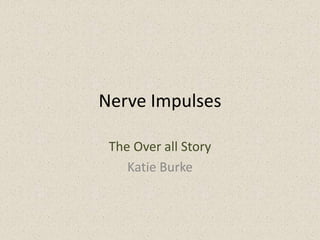
Nerve Impulses Explained
- 1. Nerve Impulses The Over all Story Katie Burke
- 2. Summary
- 3. Receptors A stimulus is received by the relevant receptors The main types of receptor are: Chemoreceptors This is for chemicals: for taste, smell and chemical concentration in the blood Mechanoreceptors For balance, touch and hearing Photoreceptors Light: for sight Thermoreceptors For temperature control and awareness of surroundings
- 4. Sodium-potassium ion pump creates concentration gradients across the membrane Potassium ions diffuse out of the cell down the potassium ion concentration gradient, making the outside of the membrane positive and the inside negative The electrical gradient will pull potassium ions back into the cell At -70mV potential difference, the two gradients counteract each other and there is no net movement of potassium ions Resting Potential
- 5. Action Potential What causes action potential? The change in the potential difference across the membrane causes a change in the shape of the Na+ gate, opening some of the voltage-dependent sodium ion channels As the sodium ions flow in, depolarisation increases, triggering more gates to open once a certain potential difference threshold is reached, thus increasing depolarisation (positive feedback) There is no way of controlling the degree of depolarisation of the membrane Action potentials are either there or they are not (all-or-nothing) Action potential is caused by changes in the permeability of the cell surface membrane to Na+ and K+ channels At the resting potential, these channels are blocked by gates preventing the flow of ions through them Changes in the voltage across the membrane cause the gates to open, and so they are referred to as voltage-dependent gated channels Depolarisation
- 7. Voltage-dependent K+ channels open due to the depolarisation of the membrane
- 8. Potassium ions move out of the axon, down the electrochemical gradient, and the inside of the cell once again becomes more negative than the outside
- 9. This is the falling phase of the oscilloscope traceRestoring the resting potential The membrane is now highly permeable to potassium ions, and more ions move out than occurs at resting potential, making the potential difference more negative than the normal resting potential (hyperpolarisation) The resting potential is re-established by closing of the voltage-dependent K+ channels and potassium ion diffusion into the axon.
- 10. At the Synapse An action potential arrives The membrane depolarises. Calcium ion channels open. Calcium ions enter the neurone Calcium ions cause synaptic vesicles containing neurotransmitter to fuse with the presynaptic membrane Neurotransmitter is released into the synaptic cleft Neurotransmitter binds with receptors on the postsynaptic membrane. Cation channels open. Sodium ions flow through the channels The membrane depolarises and initiates an action potential When released the neurotransmitter will be taken up across the presynaptic membrane (whole or after being broken down), or it can diffuse away and be broken down
- 11. Neurotransmitter Summary Neurotransmitters include acetylcholine and glutamate There are threestages leading to the nerve impulse passing along the postsynaptic neurone: Neurotransmitter release Stimulation of the postsynaptic membrane Inactivation of the neurotransmitter Neurotransmitter release When the presynaptic membrane is depolarised, channels open, increasing the permeability to calcium ions Calcium ions diffuse into the cytoplasm This causes synaptic vesicles with the neurotransmitter to diffuse with the membrane They release the neurotransmitter by exocytosis
- 12. Neurotransmitter Stimulation of the postsynaptic membrane Specificreceptor proteins in the postsynaptic membrane bind to the neurotransmitter molecule When it binds it changes shape of the protein, opening cation channels The membrane is permeable to sodium ions, causing depolarisation The extent of depolarisation is caused by the amount of neurotransmitter which depends on the frequency of impulses Inactivation of the neurotransmitter It can be actively taken up by the presynaptic membrane and reused They can rapidly diffuse from the synaptic cleft or taken up by other cells An enzyme will break it down which can be reabsorbed and reused
Editor's Notes
- SummaryReceptorsResting potentialAction potentialAt the synapseNeurotransmitter
- Action potentialResting potentialNeurotransmitter released
- Others in the green book
- The distribution of ions found in the solutions inside and outside a squid giant axon is unequal.
- There is a higher concentration of sodium ions outside of the axon, so sodium ions flow rapidly inwards through the open voltage-dependent Na+ channels, causing a build-up of positive charges inside. This reverses the polarity of the membrane. This is where the potential difference reaches +40mV.
- If hundreds of action potentials occur in the neurone, the sodium ion concentration inside the cell rises significantly. The sodium-potassium pumps start to function, restoring the original ion concentrations across the cell membrane. If a cell is not transmitting many action potentials, these pumps will not have to be used very frequently. At rest there is some slow leakage of sodium ions into the axon. These sodium ions are pumped back out of the cell.
- The gap is about 20-50 nm and a nerve impulse cannot jump across it.
- The neurotransmitter takes about 0.5 ms to diffuse across the synaptic cleft and reach the postsynaptic membrane. A single impulse will not usually be enough and several impulses are usually required to generate enough neurotransmitter to depolarise the postsynaptic membrane.The number of functioning receptors in the postsynaptic membrane will also influence the degree of depolarisation.
